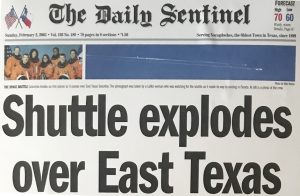Recalling the Shuttle Columbia Tragedy
by admin | February 2, 2018 8:43 am
Fifteen years ago, on Feb. 1, 2003, on a cloudless, spring-like Saturday morning as I walked out of my door in Nacogdoches shortly before 8, a sonic boom rattled the windows. NPR had just reported the shuttle Columbia was headed to land in Florida. I figured the boom, followed by a series of rumbles, was the shuttle passing overhead. I had seen the shuttle pass over on past flights, a quick flash of orange streaking across the sky, but not this time.
As I have written before, minutes later, pieces of the shuttle began raining down over Nacogdoches and much of Deep East Texas. I rushed to work at the newspaper and began frantically calling my staff. It was quickly clear that our small crew would be covering the biggest story of their careers. Within a few hours, our town filled with satellite trucks and journalists, National Guardsmen, sightseers, and hundreds of volunteer recovery workers. That scene was repeated in other towns throughout the Piney Woods — Lufkin [1], San Augustine and Hemphill in particular. Columbia’s crew of five men and two women perished in the explosion, a fact never far from the minds of those searching for shuttle debris.
[1], San Augustine and Hemphill in particular. Columbia’s crew of five men and two women perished in the explosion, a fact never far from the minds of those searching for shuttle debris.
By the end of Sunday, the next day, more than 800 recovery workers were scouring Nacogdoches County, while over a thousand were doing the same in Sabine and San Augustine counties. By midweek, 350 DPS troopers also arrived to serve as custodians for the evidence collected by the recovery crews. An estimated 300 media personnel had arrived by the weekend. A few dozen camped out in our small newspaper office. Hotels were full in Nacogdoches, Lufkin and other neighboring towns.
For a week, our staffs in Nacogdoches and Lufkin, along with reporters and photographers from the Longview paper (all were owned by Cox at the time) worked long hours covering recovery workers, who put in even-longer hours in often miserable weather, as winter returned a few days later, a cold rain pelting them. They placed blue flags, similar to the type used to mark utility lines, everywhere a piece of shuttle debris was recovered.
A few weeks later, I walked through a pasture where recovery workers had searched. Hundreds of flags dotted the pasture, a scene repeated in a long, sad swath of East Texas. More than 10,000 professionals from 42 states participated in the search over the course of nearly two months. They left their mark on our communities. Small memorials have been established in the various towns that hosted recovery efforts. There is one in Hemphill, in Sabine County near the Louisiana border. Another was placed at Arlington National Cemetery in Virginia. A small marker was placed behind Commercial National Bank in Nacogdoches, where a piece the size of the hood of a car landed in a parking lot. I remember seeing DPS troopers guarding that piece when I was able to escape the newsroom for a few minutes that Saturday.
When a small town, or in this case several small towns, become the focus of national attention, it can bring out the best or worst in people. In the case of the Columbia disaster, for the most part it brought out the best. The response by the local leaders who put together the initial search-and-recovery efforts was quick, well-organized and drew praise — especially from NASA. Hundreds of people volunteered their time; restaurants donated meals to feed volunteers; businesses provided gloves and ponchos as the weather quickly turned foul.
As a child, I avidly followed the space program and dreamed for a time of being an astronaut. My Uncle Al was in the Navy in the 1960s and served on the U.S.S. Wasp, an aircraft carrier used to recover the Gemini astronauts after they landed in the ocean. Uncle All sent me NASA photos and a few patches, which I treasured. One of my fondest memories is as a paperboy selling an extra of the Longview Daily News in July 1969, when Apollo 11 landed on the moon.
The Columbia disaster certainly shook America’s faith in the space program. The shuttles eventually returned to service but have since been mothballed. Since, NASA has not launched any manned flights. Our astronauts fly on Russian rockets to the space station.
I hope manned space flight returns. It is expensive and certainly dangerous — lives were lost when Apollo 1 caught fire, when the Challenger exploded upon launch, and Columbia’s disintegration upon return. A number of private companies are forging ahead, even as NASA is essentially hamstrung by lack of funding. We should continue efforts to explore the last frontier, even as we mourn those whose lives were lost.
- [Image]: http://garyborders.com/pages/recalling-the-shuttle-columbia-tragedy/shuttle-sentinel/
Source URL: https://garyborders.com/pages/recalling-the-shuttle-columbia-tragedy/